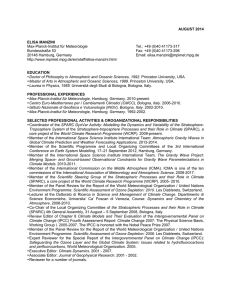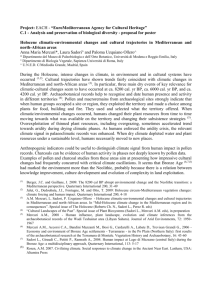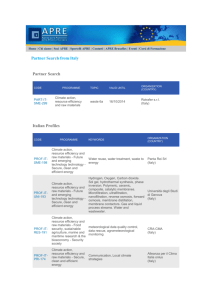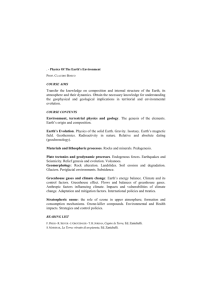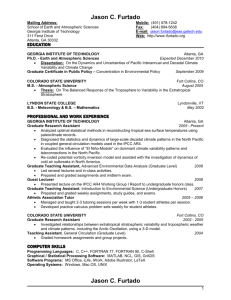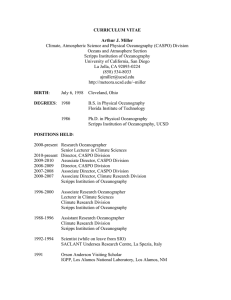J. Climate - Art Miller - University of California, San Diego
advertisement
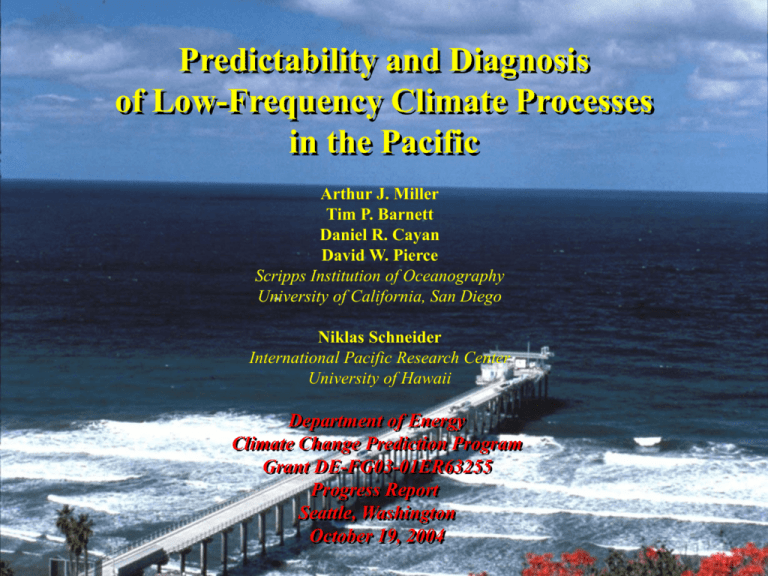
Predictability and Diagnosis of Low-Frequency Climate Processes in the Pacific Arthur J. Miller Tim P. Barnett Daniel R. Cayan David W. Pierce Scripps Institution of Oceanography University of California, San Diego Niklas Schneider International Pacific Research Center University of Hawaii Department of Energy Climate Change Prediction Program Grant DE-FG03-01ER63255 Progress Report Seattle, Washington October 19, 2004 Predictability and Diagnosis of Low-Frequency Climate Processes in the Pacific Research Topics 1) The fundamental dynamics of decadal climate variability in the Pacific Ocean, including predictability and the expected effects of anthropogenic forcing. 2) The techniques of making and evaluating climate predictions, including initial conditions, surface boundary forcing, and statistical techniques for diagnosing state-of-the-art GCMs. 3) Regional predictability of natural and forced climate changes over western subcontinental North America including the coastal ocean. Addresses a major scientific objective of the BER CCRD: “accurate prediction of future climate on decadal to centennial timescales.” Predictability and Diagnosis of Low-Frequency Climate Processes in the Pacific Recent publications supported by DOE: Barnett, T. P., D. W. Pierce, M. Latif, D. Dommenget, R. Saravanan, 1999:Geophys. Res. Lett., 26, 615-618. Barnett, T. P, D. W. Pierce, R. Schnur, 2001: Science, 292, 270-274. Di Lorenzo, E., A. J. Miller, N. Schneider, J. C. McWilliams, 2004: J. Phys. Oceanogr., in press. Hidalgo, H.G., D. R. Cayan, M. D. Dettinger, 2004:J. Hydrometeorol., submitted. Mestas-Nunez, A. M., A. J. Miller, 2004: Progr. Oceanogr., in press. Miller, A. J., A. J. Gabric, J. R. Moisan, F. Chai, D. J. Neilson, D. W. Pierce, and E. Di Lorenzo, 2004: In: Global Climate Change and Response of the Carbon Cycle in the Equatorial Pacific and Indian Oceans and Adjacent Land Masses, Elsevier Oceanography Series, submitted. Pierce, D. W., 2001: Prog. Oceanogr., 49, 331-352. Pierce, D. W., 2002: J. Climate, 15, 1295-1308. Pierce, D. W., 2004: Climatic Change, 62, 389-418. Pierce, D. W., 2004: Computing in Science and Engineering, in press. Schneider, N., 2000:.Geophys. Res. Lett., 27, 257-260. Schneider, N., 2004: J. Climate, 17, 1083-1095. Schneider, N. and A. J. Miller, 2001: J. Climate, 14, 3997-4002. Schneider, N. and B. D. Cornuelle, 2004: J. Climate, submitted. Schneider, N., A. J. Miller and D. W. Pierce, 2002: J. Climate, 15, 586-605. Schneider, N., E. Di Lorenzo and P. P. Niiler, 2004: J. Phys. Oceanogr., submitted. Stewart, I., Cayan, D. R., and M.D. Dettinger, 2004: Climatic Change, 62, 217-232. Stewart, I., Cayan, D. R., and M.D. Dettinger, 2004: J. Climate, submitted. Yulaeva, E., N. Schneider, D. W. Pierce and T. Barnett, 2001: J. Climate, 14, 4027-4046. Zhu, C., D. W. Pierce, T. P. Barnett, A. W. Wood, and D. P. Lettenmaier, 2004:Climatic Change, 62, 45-74. Selected Research Highlights Since Last DOE CCPP Meeting • Forcing of the Pacific Decadal Oscillation (Schneider, also see poster) • Validating climate model higher-order statistics (Pierce/Barnett, also see poster) • Trends in the onset of western U.S. streamflow and relationship to PDO (Cayan) • Future changes in California Current circulation under global warming scenario (Miller) What Forces the Pattern and Timescales of the Pacific Decadal Oscillation? Nov-Mar PDO: a response of North Pacific SST to • El Nino • Aleutian Low • Transport of the Kuroshio/Oyashio Extension Schneider and Cornuelle, J. Climate, submitted Hindcast of annual averaged values of SST: the PDO Tn = Tn-1 + i Fi, PDO Obs. Reconst. Autoregressive model forced by n El Nino Aleutian Low KOE adjustment to Ekman pumping Observed PDO Observed NPI Reconstructed KOE NINO3.4 Schneider and Cornuelle, J. Climate, submitted Validating climate models by comparing distributions of daily temperature Colors indicate the (transformed) skew of the distribution of daily average temperature anomalies, Dec-Jan-Feb From Pierce, Computing in Science & Engineering, 2004 See poster for further details. Trends in Onset of the Spring Pulse of Streamflow • Pulse onset occurs 1-4 weeks earlier in recent period • Date of the “center of mass” of streamflow also earlier (red) in snowmelt streams… • …but later (blue) in rainfall streams along the coast (inset) Stewart, Cayan and Dettinger J. Climate, 2004 What Controls the Streamflow Changes? PDO vs. Local Temperatures • Correlation between streamflow “center of mass” (minus spring temperature index) and PDO index is weak • Correlation between streamflow “center of mass” (minus PDO index) and spring temperature index is high • Local temperatures appear to control the streamflow Stewart, Cayan and Dettinger J. Climate, 2004 Streamflow and temperature anoms: All Stations Did the 1999 PDO Reversal Affect Streamflow Timing? Epoch differences • Warm period (1977-1998) minus early cool period (1948-1976) streamflow “center of mass” shows earlier timing • Recent cool period (1999-2000) minus warm period (1977-1998) also shows earlier timing • PDO reversal does not appear to affect streamflow timing Stewart, Cayan and Dettinger J. Climate, 2004 California Current Circulation in a Global Warming Scenario Baseline: NCEP 50-yr climatology of wind stress and curl Perturbation: ACPI PCM 2040-2050 climate minus 1986-1996 climate downscaled with RSM California Current Circulation in a Global Warming Scenario Baseline: NCEP 50-yr climatology of surface heat flux Perturbation: ACPI PCM 2040-2050 climate minus 1986-1996 climate downscaled with RSM Regional SST Changes in a Global Warming Scenario Baseline: 1 deg C warming over last Perturbation: Forced by 2040-50 winds and 50 years of CalCOFI data surface heat fluxes, but not BC changes: SST warmed 0.4 - 0.7 deg C (Auad, Miller, Pierce, Di Lorenzo, in prep) Mesoscale Eddy Variance Changes in a Global Warming Scenario Baseline: Offshore variance max increased after 1976-77 shift (Di Lorenzo et al., 2004) Perturbation: Forced by 2040-50 winds and surface heat fluxes, but not BC changes: variance generally reduced (only 6 yr long run) (Auad, Miller, Pierce, Di Lorenzo, in prep) Selected Research Highlights Since Last DOE CCPP Meeting • Forcing of the Pacific Decadal Oscillation (Schneider, also see poster) • Validating climate model higher-order statistics (Pierce/Barnett, also see poster) • Trends in the onset of western U.S. streamflow and relationship to PDO (Cayan) • Future changes in California Current circulation under global warming scenario (Miller) Department of Energy Climate Change Prediction Program Grant DE-FG03-01ER63255 Thanks!
